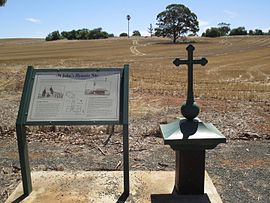Belvidere Mine
|
St Johns South Australia |
|||||||||||||||
|---|---|---|---|---|---|---|---|---|---|---|---|---|---|---|---|

View towards the former church and reformatory from the cemetery
|
|||||||||||||||
| Coordinates | 34°21′46″S 138°57′34″E / 34.36278°S 138.95944°ECoordinates: 34°21′46″S 138°57′34″E / 34.36278°S 138.95944°E | ||||||||||||||
| Postcode(s) | 5373 | ||||||||||||||
| LGA(s) | Light Regional Council | ||||||||||||||
| State electorate(s) | Stuart | ||||||||||||||
| Federal Division(s) | Wakefield | ||||||||||||||
|
|||||||||||||||
St Johns is a locality southeast of Kapunda in the northern Barossa Valley, South Australia. Originally a private subdivision on sections 1450, 1451 and 1533 of the Hundred of Belvidere, the boundaries of the locality were formalised in 2000 and the name formally adopted based on long-established use.
The foundation stone for the St John the Evangelist church was laid on 2 April 1850, however the building was not completed until 30 April 1854. A school was opened in 1859, run by the Sisters of St Joseph of the Sacred Heart after 1868. From 1897, the school became a reformatory for girls until it closed in 1909.
Belvidere (34°21′14″S 138°56′55″E / 34.3539°S 138.9486°E) is a historic locality overlapping the bounded locality of St Johns. The settlement was a consequence of the opening of Belvidere Mine, a marble mine adjacent to a crossing of the River Light (now McCarthy Bridge) and was likely named Belvidere by association to either the Hundred of Belvidere, the land administration division on the south east side of the river crossing in which the main settlement lay, or the Belvidere Range which overlooks the mine and west of the hundred.
...
Wikipedia

